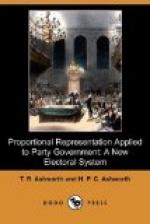With enlarged or grouped electorates the periodical revision of boundaries would be entirely obviated, because the size of the electorate may be kept constant, and the number of representatives varied. Under such a system all unfairness would disappear, and the gerrymander would be impossible. Representation would automatically follow the movements of population.
FOOTNOTES:
[4] Bryce, “The American Commonwealth,” vol ii, p 325
[5] Bryce, “The American Commonwealth,” vol. ii., note on p. 81.
[6] Governor Gerry contrived an electorate which resembled a salamander in shape.
CHAPTER VI.
THE HARE SYSTEM OF PROPORTIONAL DELEGATION.
The single transferable vote, generally known as the Hare system, was first invented by a Danish statesman, M. Andrae, and was used for the election of a portion of the “Rigsraad” in 1855. In 1857 Mr. Thomas Hare, barrister-at-law, published it independently in England in a pamphlet on “The Machinery of Representation.” This formed the basis of the scheme elaborated in his “Election of Representatives,” which appeared in 1859.
He proposed to abolish all geographical boundaries by constituting the whole of the United Kingdom one electorate for the return of the 654 members of the House of Commons. Each member was to be elected by an equal unanimous number of electors. The method of election was therefore so contrived as to allow the electors to group themselves into 654 constituencies, each group bound only by the tie of voluntary association, and gathered from every corner of the Kingdom. The total number of votes cast (about a million) was to be divided by 654, and the quotient, say about 1,500, would be the quota or number of votes required to elect a member. But some of the candidates would naturally receive more votes than the quota, and a great many more would receive less. How were all the votes to be equally divided among 654 members so that each should secure exactly the quota? The single transferable vote was proposed to attain this result. Each elector’s vote was to count for one candidate only, but he was allowed to say in advance to whom he would wish his vote transferred in case it could not be used for his first choice. Each ballot paper was, therefore, to contain the names of a number of candidates in order of preference—1, 2, 3, &c. Then all the candidates having more than a quota of first choices were to have the surplus votes taken from them and transferred to the second choice on the papers, or if the second choice already had enough votes, to the third choice, and so on. When all the surpluses were distributed a certain number of members would be declared elected, each with a quota of votes. The candidates who had received the least amount of support were then to be gradually eliminated. The lowest candidate would be first




